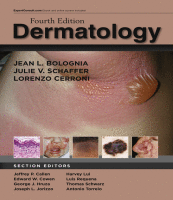Physical Address
304 North Cardinal St.
Dorchester Center, MA 02124

Atrophies of the skin that are due to a diminution or loss of collagen and/or elastic fibers are discussed in this chapter. The areas of involvement can be quite large, as in mid-dermal elastolysis, or punctate, as in follicular atrophoderma.…

This chapter will discuss disorders in which there are increased amounts of collagen within the skin, followed by those with increased elastin. Hypertrophic Scars and Keloids Key features ▪ Conventional scars are preceded by injury, immediate in onset, flat, and…

Key features ■ Heritable connective tissue disorders with skin involvement comprise a phenotypically diverse group of conditions ■ Recognition of characteristic skin findings is often critical to establishing the diagnosis and identifying associated internal involvement, which may include life-threatening cardiovascular…

Synonyms ▪ Hyperkeratosis follicularis et parafollicularis in cutem penetrans: Kyrle disease ▪ Acquired perforating dermatosis: acquired reactive perforating collagenosis, acquired reactive perforating dermatosis, perforating disorder of uremia Key features ▪ Group of disorders with transepidermal elimination of collagen, elastic tissue,…

Key features ▪ Extracellular matrices (ECMs) represent specifically organized networks of collagens, elastin, glycoproteins, and proteoglycans that have distinct structural roles and specific functional properties in all tissues ▪ ECMs are biologically active, interact with cells, and regulate their functions…

Key features ▪ Foreign body reactions represent inflammatory responses to inorganic and high-molecular-weight organic materials that have been introduced into the skin and are variably resistant to degradation ▪ Routes of introduction can vary from accidental or self-inflicted to surgical…

Introduction The granulomatous diseases discussed in this chapter may be defined as having an inflammatory cutaneous infiltrate in which histiocytes are the preponderant inflammatory cells. While cutaneous sarcoidosis is the prototype of non-infectious (sterile) granulomatous dermatitides, there are a number…

Key features ▪ Cutaneous xanthomas can signal the presence of an underlying hyperlipidemia or monoclonal gammopathy ▪ An understanding of basic lipid metabolism provides insight into the underlying hyperlipoproteinemias as well as the formation of xanthomas ▪ The major forms…

Overview The histiocytoses represent a group of proliferative disorders that share a common CD34 + progenitor cell in the bone marrow. Three “histiocytes” of cutaneous importance are: (1) the Langerhans cell , which migrates to and from the epidermis and…

Child Abuse Synonym ▪ Battered child syndrome Key features ▪ Signs of physical abuse include: unexplained bruises; injuries of the thorax, abdomen, buttocks, genitals, chin, ears, or neck; curvilinear marks; and cigarette burns or other well-demarcated burns ▪ Signs of…